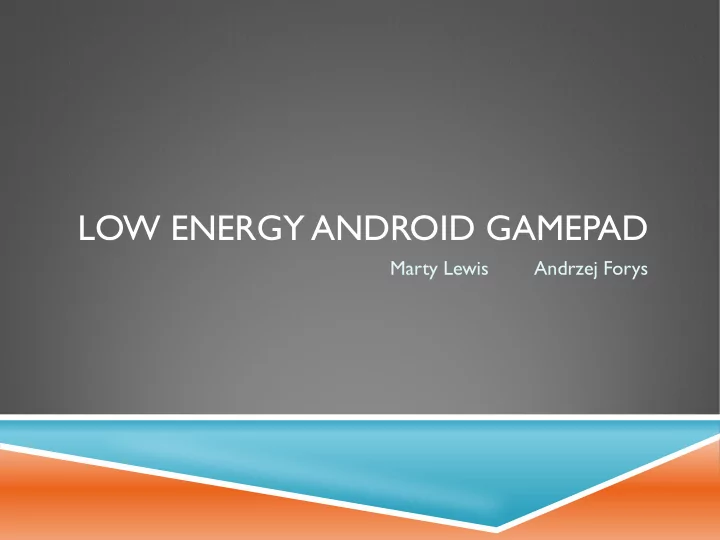

LOW ENERGY ANDROID GAMEPAD Marty Lewis Andrzej Forys
FUNCTIONAL DESCRIPTION Project Idea: Low power, wireless, silicone game pad for Android Devices Ergonomic fit with standard controller layout Six buttons (4 + two triggers) Analog joystick Wireless Near Field Communication Minimal battery usage on game pad and Android Application HID driver for Android - standard library Android game or app
IMPLEMENTATION STRATEGY Near Field Communications (NFC) Intended for quick-pay, smart billboards, RFID, etc. Low range – game pad will be physically next to host phone Low data rate – sufficient for game pad input Low power consumption for host and device Available now on Google Nexus S, soon on Samsung Galaxy S II
IMPLEMENTATION STRATEGY NFC – Active or Passive? Active Mode Both sides generate a field for 2-way communication Significantly more battery power on device Slightly less battery power on host Required if haptic feedback implemented Passive Mode Host generates a field to read the device Significantly less battery power on device Slightly more battery power on host Winner Passive mode if haptic feedback is not implemented Mixed mode w/ haptic feedback (active mode only when needed)
HARDWARE DESIGN Original Design Components Silicone game glove prototype Will be constructed using hobby silicone mold kit hobbysilicone.com First create mock device (wood or clay/ceramic) Modify mock device to fit design needs Use mock device to mold a silicone glove PCB layout and assembly (reflow) for PN531 Will incorporate most of circuit while we’re at it Interconnections and protection circuits will require design No template for HVQFN40 package? May need to make one. Maybe a custom antenna coil So far can’t find where to buy just one
SOFTWARE DESIGN Microcontroller software Poll for user inputs De-bounce (if needed) Assemble packet to transmit via NFC Communicate packet to NFC via RS-232 Android HID driver Receive incoming NFC packets from device Keyboard emulation of pressed/released keys Android game or app TBD, will demo keyboard emulation of device driver
SOFTWARE DESIGN Haptic feedback (if implemented) Microcontroller: Receive haptic requests Generate signals to drive vibration motor Control when in active/passive mode Another device driver to send haptic requests to device Demo software will need to demo this functionality
MICROCONTROLLER INTERFACE
NFC INTERFACE SPECIFICATION
USER INTERFACE SPECIFICATIONS User inputs on joystick, 4 buttons, and two triggers Default keymap: joy(-1, 0) = key_left joy(1, 0) = key_right joy(0, -1) = key_up joy(0, 1) = key_dow joy(-1, 1) = key_down+key_left joy(1, 1) = key_down+key_right joy(-1, -1) = key_up+key_left joy(1, -1) = key_up+key_right, button1 = key_a button2 = key_s button3 = key_d button4 = key_f trigger1 = key_j trigger2 = key_k Android GUI to change keymap Android apps react to emulated keys as established by keymap
PRELIMINARY PARTS LIST - BOM PN531 microcontroller (uC) based NFC transceiver Requires 27.12MHz quartz HVQFN40 package – 6mm x 6mm x 0.85mm Custom economy PCB (~$30 from PCB123) Custom plastic laser cut solder stencil (~$35 polulu.com) Solder paste and toaster oven for reflow 13.56 MHz antenna coil – small form factor, close range uC to collect inputs and talk to NFC chip via RS-232 Protection diodes/signal conditioners for I/O lines Six push-button switches Miniature analog joystick CR2025 lithium button battery and holder Maybe vibration motor(s) for haptic feedback?
SCHEDULE – PHASE 1
TEAM LEADS – PHASE 1 Task Lead Obtain a Target Host Device Andrzej PCB/Stencil Layout Marty PCB/Stencil Layout Review Andrzej Antenna Coil Design Andrzej Antenna Coil Design Review Marty Research Parts Marty Generate BOM Marty
SCHEDULE – PHASE 2
TEAM LEADS – PHASE 2 Task Lead Antenna Coil Integration Andrzej Testing Microcontroller Programming Marty Testing Microcontroller Integration Marty (PCB) NFC Testing/Integration Marty Bluetooth V2.1+EDR Andrzej Testing/Integration Android Driver Andrzej Android App Andrzej Prototype Glove Marty
SCRUM – PROGRESS TRACKER
TASK RISKS Risk Mitigation Plan Backup Plan A few Surface mount components Custom PCB/Stencil Other communication mediums, WIFI, USB New use for NFC, will it work Implement Bluetooth V2.1+EDR Other communication mediums, like we think? in tandem WIFI, USB No HVQFN40 PCB template Find one Make one, Other communication mediums, WIFI, USB Need to design antenna coil, not Study NFC Antenna Design Bluetooth V2.1+EDR only well versed in antenna design Papers Will silicone molding turn out Start early, don’t let it consume Demo without enclosure ok? too much time Both teammates have hectic Work over summer Core requirements only schedules
REFERENCES (2011, February 25) Near Field Communication PN531- UC Based Transmission Module -- Objective Short Form Specification Rev. 2.0. [Online]. Available: http://www.nxp.com/acrobat_download2/other/identification/sfs_pn531_rev2.0.pdf (2011, February 25) BLUETOOTH Low Energy-technical Facts. [Online]. Available: http://www.bluetooth.com/SiteCollectionDocuments/Bluetoothlowenergyfactsheet.pdf (2011, February 25) Near Field Communication. [Online]. Available: http://en.wikipedia.org/wiki/Near_field_communication" (2011, February 25) Google Nexus S Technical Specifications. [Online]. Available: http://www.google.com/nexus/#/tech-specs (2011, February 25) Samsung Galaxy S II Technical Specifications. [Online]. Available: http://galaxys2.samsungmobile.com/html/specification.html
QUESTIONS OR COMMENTS?
Recommend
More recommend